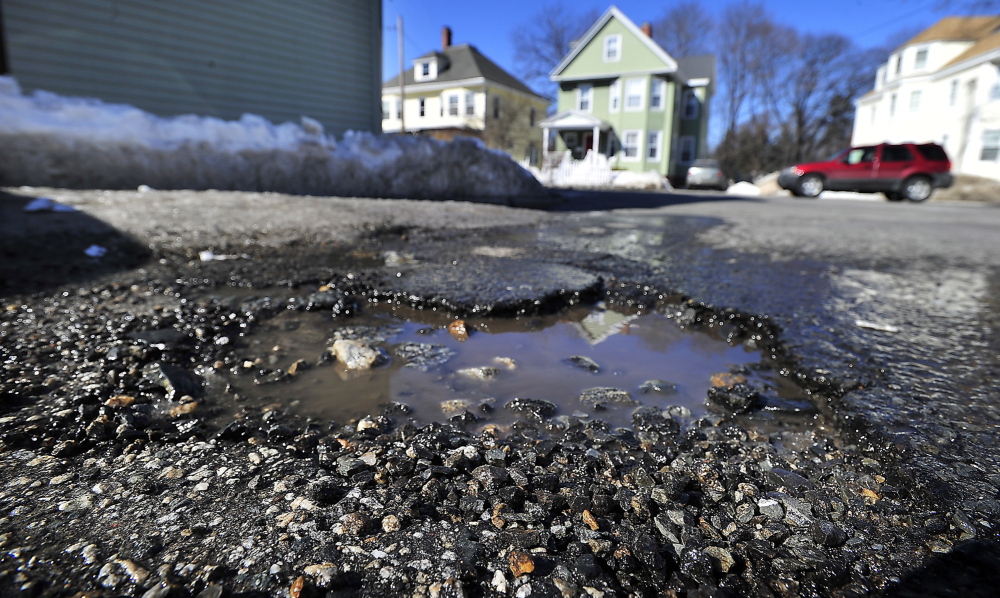The severe winter has made for more than a few bumps in the road, keeping public works crews busy patching and re-patching potholes across southern Maine.
“The extremely cold winter and some of the freeze-thaw cycles have really taken their toll on the roads,” said Patrick Fox, public works director in Saco. “Frost heave-wise and pothole-wise, it’s certainly worse than the last three or five winters.”
“It’s horrible,” said Matt Estes of Standish, a project manager for a construction company who said he drives a lot to visit work sites. “It’s the worst year I’ve ever seen.”
The city of Portland issued a warning to motorists Friday to watch out for potholes – and for workers trying to fill them.
The city has a pothole reporting hotline – 874-8493 – that has received 75 calls since early February, said Mike Bobinsky, director of public services.
That number is probably the tip of the iceberg, he said. “When our staff goes out to respond to each one of those, they find others in the vicinity.”
Officials in Saco and South Portland say the never-ending pothole problem has kept crews busy on weekends, as well, adding to overtime costs that are stretching municipal budgets this winter.
“At any weak area in the road, it seems like the potholes get in there overnight,” said Mark Lorello, superintendent of public works in South Portland.
Potholes form when water weakens the soil under the street and traffic stresses the pavement to the point where it breaks down. Winter accelerates the process because freezing and thawing creates cracks for water to enter.
Frost heaves, which are a bigger problem on rural roads than on city streets, are caused by freezing and thawing that creates bumps in the pavement.
Both can rattle drivers’ nerves and damage vehicles, usually by flattening tires or bending wheel rims.
Estes, the construction project manager, said he hasn’t damaged his pickup truck, which looks big and sturdy enough to handle a sizable sinkhole. But, he said, he still watches where he drives and remembers where the bad stretches are so he can avoid them.
Kristian Terison of Falmouth can rattle off a list of bad spots for potholes, beginning with Payson Park, some parts of Falmouth and his least favorite stretch, Portland Street in Portland, between Forest Avenue and Preble Street.
“It looks like the moon,” he said.
Others said potholes pretty much go with the territory, and are as much a sign of the season as melting piles of snow.
“It’s spring” shrugged Mercedes Mendez-Swanson of New Gloucester. “It’s about the same as always. It’s bad, but that’s normal.”
Drivers who hit the big ones may not be so forgiving.
“Last Friday we had a pretty big pothole develop out on Main Street (in South Portland),” Lorello said. “It was reported that one car had two flat tires and another car had one flat.”
Melting snow had filled the hole with water, so “it looked like a puddle and they hit it,” he said.
Such damage often leads to claims against cities and towns, but rarely leads to a city or town paying for repairs.
Maine’s so-called 24-hour law gives a municipality 24 hours from the time it receives a report of a pothole or a road hazard to patch it or post warning signs. Only after the 24-hour period is the community liable for any damage costs.
The potholes that are patched now on a temporary basis – sometimes multiple times – will have to be ground out and repaved in the summer, at additional cost. The work will leave less money for repaving projects this year.
“At best, it’s really just a temporary repair” in the winter, Lorello said. “Sometimes it’s temporary for the day.”
Lorello said several sections of Highland Avenue are “unraveling on us” and have needed lots of patching and re-patching. The city will move the street up on the paving schedule because of all the damage this winter, but probably won’t be able to repave it this year, he said.
The cost of pothole repairs is adding to the toll of an already expensive winter for cities and towns. Portland, for example, budgeted nearly $1 million for snow removal and has spent $1.2 million so far – with all of March left to go.
All of that plowing and sanding is likely contributing to the pothole problem, Lorello said
“We’ve certainly been out there pounding the roads with the plows,” he said. “It’s something that you just have to do.”
Send questions/comments to the editors.




Success. Please wait for the page to reload. If the page does not reload within 5 seconds, please refresh the page.
Enter your email and password to access comments.
Hi, to comment on stories you must . This profile is in addition to your subscription and website login.
Already have a commenting profile? .
Invalid username/password.
Please check your email to confirm and complete your registration.
Only subscribers are eligible to post comments. Please subscribe or login first for digital access. Here’s why.
Use the form below to reset your password. When you've submitted your account email, we will send an email with a reset code.